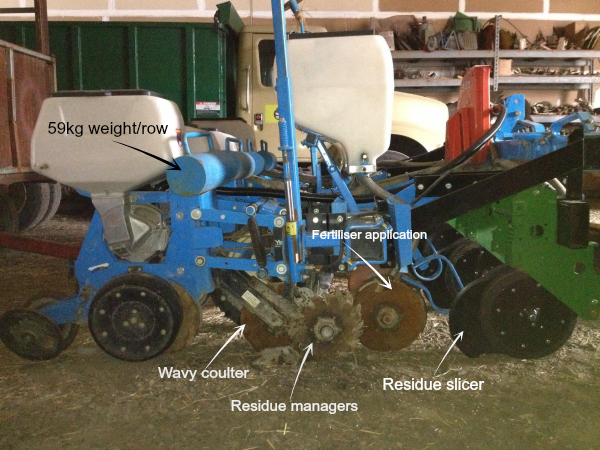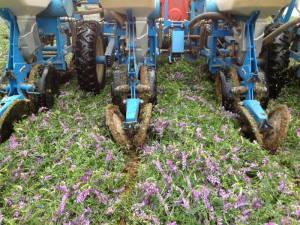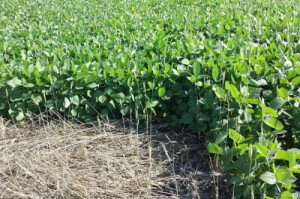If we can achieve a thick, deep mulch of material on the soil surface from a cover crop, it is great for weed control, and for preventing soil moisture loss. But, what is the best method for planting into this thick mat of cover crop residue?
I will share with you what Jeff Moyer, Farm Director from the Rodale Institute in the US has done with his planter to adapt it for planting his grain crops into the mulch, created from a rolled down cover crop. The Rodale Institute are conducting cutting edge research into organic no-till practices, in the US.
If you haven’t already done so, I suggest reading my past cover cropping blogs The ‘New’ Cover Cropping, Experiences from the U.S. – Cover Cropping and last week’s The Practicalities of Cover Cropping – Crop Termination.
Jeff has a Monosem planter. They are a double disc precision planter, favoured in the vegetable industry due to its ability to plant a wide range of seed sizes with precision. Jeff has added an extra couple of tool bars to the planter, to aid with planting into the mulch of a cover crop.
At the front of the planter is a set of residue slicers which consist of two wide rubber press wheels and a coulter in between. Jeff explains their role by pointing out how difficult it is to cut a piece of paper with a knife if holding the paper with one hand. If however, we were to hold the paper taught with two hands then the knife would slice readily through it. The wide press wheels hold the rolled crop in place, while the coulter cuts through it. It will also prevent the residue from being pushed into the slot as the coulter places pressure to cut through the material.
Next is a double offset disc through which fertiliser is applied.
This is followed by a set of Yetter shark tooth residue managers, which help to part the mulch for planting. Because Jeff’s farming system is no till organic, he relies on the cover crop mulch for his weed control, he is careful about not moving too much material away from the plant line. It will also depend on the cover crop he is sowing into. Jeff will certainly use them when sowing into something like a cereal rye, but is likely to leave the residue managers off if sowing into a legume cover crop.
Right behind this is a wavy coulter which helps to create a wide seed slot and to shatter the wall of the sowing slot.
Next is where the seed is planted – with a double disc opener, and finally there are cast iron closing wheels to firm the seed in. Cast iron is chosen to ensure adequate seed soil contact with all of the plant material present. Here is Jeff’s planter sowing into a hairy vetch cover crop.
Jeff also places 59kg (130pounds) of weight over the coulter of each row, in order to ensure that the planter pushes down into the matt of material.
While there is a lot of residue from the cover crop to get through with the planter, crop seeds are often larger and more robust than the small seeds of many weed species, giving them greater likelihood of success.
It is quite amazing to see the immense amount of dry matter that can be grown and still sown into with appropriate crop termination and planting gear. Each cover crop species selection will vary depending on what it is we are trying to achieve and the planter setup will change accordingly, as you can see Jeff has done. Working out the best way to make newer techniques work in our own farming systems is not necessarily going to be straight forward or simple. Neither however are current conventional farming practices simple, with herbicide resistance, the need for double knock strategies and decreasing margins. It’s time to start giving new systems a go.
Thanks to AerodromeAg, a subscriber who made some comments last week that you all may be interested in (see comments section after the post). Thanks for paving the way for other Australian farmers. You are helping to tweek the cover cropping system to suit different conditions and environments, so that others may gain the confidence to adopt such techniques.
Maybe anyone that has tried cover cropping can share with us whether you have had to make any planter adjustments in order to plant through the material from your cover crops, regardless of you termination technique or timing.



